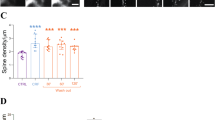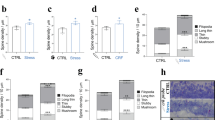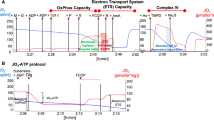Abstract
Dendritic spines are important sites of excitatory neurotransmission in the brain with their function determined by their structure and molecular content. Alterations in spine number, morphology and receptor content are a hallmark of many psychiatric disorders, most notably those because of stress. We investigated the role of corticotropin-releasing factor (CRF) stress peptides on the plasticity of spines in the cerebellum, a structure implicated in a host of mental illnesses, particularly of a developmental origin. We used organotypic slice cultures of the cerebellum and restraint stress in behaving animals to determine whether CRF in vitro and stress in vivo affects Purkinje cell (PC) spine density. Application of CRF and urocortin (UCN) to cerebellar slice cultures increased the density of spines on PC signaling via CRF receptors (CRF-Rs) 1 and 2 and RhoA downregulation, although the structural phenotypes of the induced spines varied, suggesting that CRF-Rs differentially induce the outgrowth of functionally distinct populations of spines. Furthermore, CRF and UCN exert a trophic effect on the surface contact between synaptic elements by increasing active zones and postsynaptic densities and facilitating the alignment of pre- and post-synaptic membranes of synapses on PCs. In addition, 1 h of restraint stress significantly increased PC spine density compared with those animals that were only handled. This study provides unprecedented resolution of CRF pathways that regulate the structural machinery essential for synaptic transmission and provides a basis for understanding stress-induced mental illnesses.
This is a preview of subscription content, access via your institution
Access options
Subscribe to this journal
Receive 12 print issues and online access
$259.00 per year
only $21.58 per issue
Buy this article
- Purchase on Springer Link
- Instant access to full article PDF
Prices may be subject to local taxes which are calculated during checkout





Similar content being viewed by others
References
McEwen BS, Gianaros PJ . Central role of the brain in stress and adaptation: links to socioeconomic status, health, and disease. Ann NY Acad Sci 2010; 1186: 190–222.
McEwen BS . The ever-changing brain: cellular and molecular mechanisms for the effects of stressful experiences. Dev Neurobiol 2011; doi:10.1002/dneu.20968.
Stewart MG, Davies HA, Sandi C, Kraev IV, Rogachevsky VV, Peddie CJ et al. Stress suppresses and learning induces plasticity in CA3 of rat hippocampus: a three-dimensional ultrastructural study of thorny excrescences and their postsynaptic densities. Neuroscience 2005; 131: 43–54.
Sunanda Rao MS, Raju TR . Effect of chronic restraint stress on dendritic spines and excrescences of hippocampal CA3 pyramidal neurons--a quantitative study. Brain Res 1995; 694: 312–317.
McLaughlin KJ, Baran SE, Conrad CD . Chronic stress- and sex-specific neuromorphological and functional changes in limbic structures. Mol Neurobiol 2009; 40: 166–182.
Bhatt DH, Zhang S, Gan WB . Dendritic spine dynamics. Annu Rev Physiol 2009; 71: 261–282.
Lee KJ, Kim H, Rhyu IJ . The roles of dendritic spine shapes in Purkinje cells. Cerebellum 2005; 4: 97–104.
Llinas R, Welsh JP . On the cerebellum and motor learning. Curr Opin Neurobiol 1993; 3: 958–965.
Leiner HC . Solving the mystery of the human cerebellum. Neuropsychol Rev 2010; 20: 229–235.
Stoodley CJ, Schmahmann JD . Evidence for topographic organization in the cerebellum of motor control versus cognitive and affective processing. Cortex 2010; 46: 831–844.
Yin Y, Li L, Jin C, Hu X, Duan L, Eyler LT et al. Abnormal baseline brain activity in posttraumatic stress disorder: a resting-state functional magnetic resonance imaging study. Neurosci Lett 2011; 498: 185–189.
Xing G, Carlton J, Zhang L, Jiang X, Fullerton C, Li H et al. Cannabinoid receptor expression and phosphorylation are differentially regulated between male and female cerebellum and brain stem after repeated stress: implication for PTSD and drug abuse. Neurosci Lett 2011; 502: 5–9.
Dautzenberg FM, Hauger RL . The CRF peptide family and their receptors: yet more partners discovered. Trends Pharmacol Sci 2002; 23: 71–77.
Binder EB, Nemeroff CB . The CRF system, stress, depression and anxiety-insights from human genetic studies. Mol Psychiatry 2010; 15: 574–588.
Chen Y, Bender RA, Brunson KL, Pomper JK, Grigoriadis DE, Wurst W et al. Modulation of dendritic differentiation by corticotropin-releasing factor in the developing hippocampus. Proc Natl Acad Sci USA 2004; 101: 15782–15787.
Chen Y, Rex CS, Rice CJ, Dube CM, Gall CM, Lynch G et al. Correlated memory defects and hippocampal dendritic spine loss after acute stress involve corticotropin-releasing hormone signaling. Proc Natl Acad Sci USA 2010; 107: 13123–13128.
Swinny JD, Metzger F, IJkema-Paassen J, Gounko NV, Gramsbergen A, van der Want JJ . Corticotropin-releasing factor and urocortin differentially modulate rat Purkinje cell dendritic outgrowth and differentiation in vitro. Eur J Neurosci 2004; 19: 1749–1758.
Tyler WJ, Pozzo-Miller LD . BDNF enhances quantal neurotransmitter release and increases the number of docked vesicles at the active zones of hippocampal excitatory synapses. J Neurosci 2001; 21: 4249–4258.
Swinny JD, Valentino RJ . Corticotropin-releasing factor promotes growth of brain norepinephrine neuronal processes through Rho GTPase regulators of the actin cytoskeleton in rat. Eur J Neurosci 2006; 24: 2481–2490.
Hauger RL, Risbrough V, Brauns O, Dautzenberg FM . Corticotropin releasing factor (CRF) receptor signaling in the central nervous system: new molecular targets. CNS Neurol Disord Drug Targets 2006; 5: 453–479.
Bishop GA, Seelandt CM, King JS . Cellular localization of corticotropin releasing factor receptors in the adult mouse cerebellum. Neuroscience 2000; 101: 1083–1092.
Riegel AC, Williams JT . CRF facilitates calcium release from intracellular stores in midbrain dopamine neurons. Neuron 2008; 57: 559–570.
Zakharenko S, Chang S, O’Donoghue M, Popov SV . Neurotransmitter secretion along growing nerve processes: comparison with synaptic vesicle exocytosis. J Cell Biol 1999; 144: 507–518.
Hioki H, Fujiyama F, Taki K, Tomioka R, Furuta T, Tamamaki N et al. Differential distribution of vesicular glutamate transporters in the rat cerebellar cortex. Neuroscience 2003; 117: 1–6.
Sigrist SJ, Schmitz D . Structural and functional plasticity of the cytoplasmic active zone. Curr Opin Neurobiol 2011; 21: 144–150.
Kim E, Sheng M . PDZ domain proteins of synapses. Nat Rev Neurosci 2004; 5: 771–781.
Takeuchi T, Miyazaki T, Watanabe M, Mori H, Sakimura K, Mishina M . Control of synaptic connection by glutamate receptor delta2 in the adult cerebellum. J Neurosci 2005; 25: 2146–2156.
McEwen BS, Eiland L, Hunter RG, Miller MM . Stress and anxiety: structural plasticity and epigenetic regulation as a consequence of stress. Neuropharmacology 2011; 62: 3–12.
Mychasiuk R, Gibb R, Kolb B . Prenatal bystander stress induces neuroanatomical changes in the prefrontal cortex and hippocampus of developing rat offspring. Brain Res 2011; 1412: 55–62.
Bock J, Murmu MS, Biala Y, Weinstock M, Braun K . Prenatal stress and neonatal handling induce sex-specific changes in dendritic complexity and dendritic spine density in hippocampal subregions of prepubertal rats. Neuroscience 2011; 193: 34–43.
Martinez-Tellez RI, Hernandez-Torres E, Gamboa C, Flores G . Prenatal stress alters spine density and dendritic length of nucleus accumbens and hippocampus neurons in rat offspring. Synapse 2009; 63: 794–804.
Shansky RM, Hamo C, Hof PR, McEwen BS, Morrison JH . Stress-induced dendritic remodeling in the prefrontal cortex is circuit specific. Cereb Cortex 2009; 19: 2479–2484.
Liston C, Gan WB . Glucocorticoids are critical regulators of dendritic spine development and plasticity in vivo. Proc Natl Acad Sci USA 2011; 108: 16074–16079.
Ito M . Mechanisms of motor learning in the cerebellum. Brain Res 2000; 886: 237–245.
Miyata M, Okada D, Hashimoto K, Kano M, Ito M . Corticotropin-releasing factor plays a permissive role in cerebellar long-term depression. Neuron 1999; 22: 763–775.
Penzes P, Cahill ME, Jones KA, VanLeeuwen JE, Woolfrey KM . Dendritic spine pathology in neuropsychiatric disorders. Nat Neurosci 2011; 14: 285–293.
Gorman JM, Docherty JP . A hypothesized role for dendritic remodeling in the etiology of mood and anxiety disorders. J Neuropsychiatry Clin Neurosci 2010; 22: 256–264.
Segal M . Dendritic spines and long-term plasticity. Nat Rev Neurosci 2005; 6: 277–284.
Kasai H, Fukuda M, Watanabe S, Hayashi-Takagi A, Noguchi J . Structural dynamics of dendritic spines in memory and cognition. Trends Neurosci 2010; 33: 121–129.
Fiala JC, Spacek J, Harris KM . Dendritic spine pathology: cause or consequence of neurological disorders? Brain Res Brain Res Rev 2002; 39: 29–54.
Cingolani LA, Goda Y . Actin in action: the interplay between the actin cytoskeleton and synaptic efficacy. Nat Rev Neurosci 2008; 9: 344–356.
Negishi M, Katoh H . Rho family GTPases and dendrite plasticity. Neuroscientist 2005; 11: 187–191.
Li Z, Van Aelst L, Cline HT . Rho GTPases regulate distinct aspects of dendritic arbor growth in Xenopus central neurons in vivo. Nat Neurosci 2000; 3: 217–225.
Chen Y, Kramar EA, Chen LY, Babayan AH, Andres AL, Gall CM et al. Impairment of synaptic plasticity by the stress mediator CRH involves selective destruction of thin dendritic spines via RhoA signaling. Mol Psychiatry; advance online publication, 13 March 2012; doi:10.1038/mp.2012.17.
Mueller BK, Mack H, Teusch N . Rho kinase, a promising drug target for neurological disorders. Nat Rev Drug Discov 2005; 4: 387–398.
Acknowledgements
We thank Scott Rodaway and all members of the bio-resources team of the School of Pharmacy and Biomedical Sciences, University of Portsmouth, for assistance with experimental work.
Author information
Authors and Affiliations
Corresponding author
Ethics declarations
Competing interests
The authors declare no conflict of interest.
Additional information
Supplementary Information accompanies the paper on the Molecular Psychiatry website
Rights and permissions
About this article
Cite this article
Gounko, N., Swinny, J., Kalicharan, D. et al. Corticotropin-releasing factor and urocortin regulate spine and synapse formation: structural basis for stress-induced neuronal remodeling and pathology. Mol Psychiatry 18, 86–92 (2013). https://doi.org/10.1038/mp.2012.43
Received:
Revised:
Accepted:
Published:
Issue Date:
DOI: https://doi.org/10.1038/mp.2012.43
Keywords
This article is cited by
-
Cdk5-dependent rapid formation and stabilization of dendritic spines by corticotropin-releasing factor
Translational Psychiatry (2024)
-
Corticotropin-releasing factor induces functional and structural synaptic remodelling in acute stress
Translational Psychiatry (2021)
-
Urocortins in the mammalian endocrine system
Acta Veterinaria Scandinavica (2019)
-
Corticotropin releasing factor-binding protein (CRF-BP) as a potential new therapeutic target in Alzheimer’s disease and stress disorders
Translational Psychiatry (2019)
-
cAMP-dependent cell differentiation triggered by activated CRHR1 in hippocampal neuronal cells
Scientific Reports (2017)



